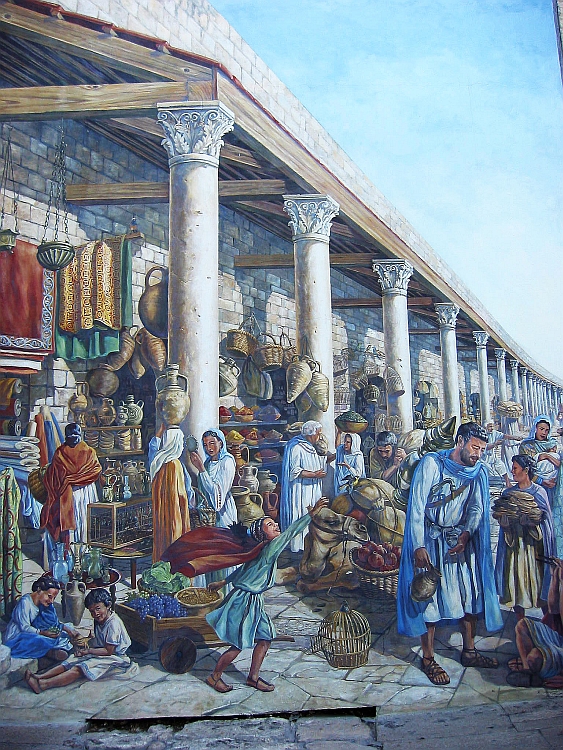|
Wohl Archaeological Museum
The Herodian Quarter – Wohl Archaeological Museum is an underground archaeological site and museum situated in the Jewish Quarter of the Old City of Jerusalem. It exhibits lavish residencies that reflect the high standard of living among the affluent inhabitants of Jerusalem's Upper City during the late Second Temple Period and up until the city's destruction in 70 CE. Among the exhibits are five residential buildings dating back to the Herodian period, believed to have been inhabited by priestly families, complete with ritual baths, bathhouses, and household items. The wall paintings and architectural elements are designed according to Hellenistic and Roman styles. The "Palatial Mansion" stands out with its multi-level layout surrounding a central courtyard. This grand residence includes an ornate reception area decorated in a style found in Pompeii, also featuring remnants of collapsed wooden beams, evidence of the city's destruction. Numerous smaller discoveries were une ... [...More Info...] [...Related Items...] OR: [Wikipedia] [Google] [Baidu] |
Old City Of Jerusalem
The Old City of Jerusalem (; ) is a walled area in Jerusalem. In a tradition that may have begun with an 1840s British map of the city, the Old City is divided into four uneven quarters: the Muslim Quarter, the Christian Quarter, the Armenian Quarter, and the Jewish Quarter. A fifth area, the Temple Mount, known to Muslims as Al-Aqsa or ''Haram al-Sharif'', is home to the Dome of the Rock, the Al-Aqsa Mosque, and was once the site of the Jewish Temple. The Old City's current walls and city gates were built by the Ottoman Empire from 1535 to 1542 under Suleiman the Magnificent. The Old City is home to several sites of key importance and holiness to the three major Abrahamic religions: the Temple Mount and the Western Wall for Judaism, the Church of the Holy Sepulchre for Christianity, and the Dome of the Rock and al-Aqsa Mosque for Islam. The Old City, along with its walls, was added to the World Heritage Site list of UNESCO in 1981. In spite of its name, the Old City ... [...More Info...] [...Related Items...] OR: [Wikipedia] [Google] [Baidu] |
Jewish Quarter (Jerusalem)
The Jewish Quarter (; ) is one of the four traditional quarters of the Old City (Jerusalem), Old City of Jerusalem. The area lies in the southwestern sector of the walled city, and stretches from the Gates in Jerusalem's Old City Walls, Zion Gate in the south, along the Armenian Quarter on the west, up to the Street of the Chain in the north and extends to the Western Wall and the Temple Mount in the east. In the early 20th century the Jews, Jewish population of the quarter reached 19,000. During the 1948 Palestine war, 1948 war, the Jewish Quarter fought the Arab Legion as part of the battle for Jerusalem, and the Hurva Synagogue, Hurva synagogue was blown up by Arab legionnaires. In May 1948, the Jewish Quarter surrendered; some Jews were taken captive, and the rest were evacuated. A crowd then systematically pillaged and razed the quarter. After Israel captured East Jerusalem during the Six-Day War, 1967 Six-Day War, the quarter was earmarked for rehabilitation as a tourist ... [...More Info...] [...Related Items...] OR: [Wikipedia] [Google] [Baidu] |
Temple Menorah
The Temple menorah (; , Tiberian Hebrew ) is a seven-branched candelabrum that is described in the Hebrew Bible and later ancient sources as having been used in the Tabernacle and the Temple in Jerusalem. Since ancient times, it has served as a symbol representing the Jews and Judaism in both the Land of Israel and the Jewish diaspora. It became the State of Israel's official emblem when it was founded in 1948. According to the Hebrew Bible, the menorah was made out of Gold#Religion, pure gold, and the only source of fuel that was allowed to be used to light the lamps was olive oil#Judaism, fresh olive oil. The menorah was placed in the Tabernacle. Biblical tradition holds that Solomon's Temple was home to ten menorahs, which were later plundered by the Judah's revolts against Babylon, Babylonians; the Second Temple is also said to have been home to a menorah. Following the Siege of Jerusalem (70 CE), Roman destruction of Jerusalem and the Temple in 70 CE, the menorah was taken ... [...More Info...] [...Related Items...] OR: [Wikipedia] [Google] [Baidu] |
Miqva'ot
A mikveh or mikvah (, ''mikva'ot'', ''mikvot'', or (Ashkenazi Hebrew, Ashkenazic) ''mikves'', lit., "a collection") is a bath used for ritual washing in Judaism#Full-body immersion, ritual immersion in Judaism to achieve Tumah and taharah, ritual purity. In Orthodox Judaism, these regulations are steadfastly adhered to; consequently, the mikveh is central to an Orthodox Jewish community. Conservative Judaism also formally holds to the regulations. The existence of a mikveh is considered so important that, according to Halakha, halacha, a Jewish community is required to construct a kosher mikveh even before building a synagogue, and must go to the extreme of selling Torah scrolls, or even a synagogue if necessary, to provide funding for its construction. Etymology Formed from the Semitic root ק-ו-ה (''q-w-h'', "collect"). In the Hebrew Bible, the word is employed in the sense of "collection", including in the phrase מקוה המים (''miqwêh hammayim'', "collection of ... [...More Info...] [...Related Items...] OR: [Wikipedia] [Google] [Baidu] |




